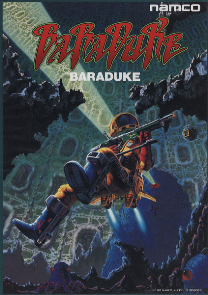Baraduke
You can help expand this article with text translated from the corresponding article in Japanese. (March 2012) Click [show] for important translation instructions.
|
| Baraduke | |
|---|---|
 Arcade flyer | |
| Developer(s) | Namco Dempa (Sharp X68000) |
| Platform(s) | Arcade, Sharp X68000, Wii (Virtual Console) |
| Release | Arcade'Sharp X68000'Wii Virtual Console |
| Genre(s) | Scrolling shooter |
| Mode(s) | Up to 2 players, alternating turns |
| Arcade system | Namco Pac-Land |
Baraduke (バラデューク, Baradyūku), also known as Alien Sector, is a scrolling shooter arcade game originally released by Namco in 1985.
Gameplay

The gameplay system is similar to the Metroid series of games. The player takes control of a spacewoman in a biohazard suit, Player 1 is Kissy and Player 2 is Takky. They must clear eight worlds of increasing difficulty (each one is composed of five regular floors and one boss floor) by using their wave guns to destroy all the enemies populating them. They must also save the one-eyed Paccets for extra points and the chance to earn another shield in the end-of-floor bonus games.
On each floor there are a certain amount of enemies known as Octy, which will leave power-up capsules behind when defeated. Defeating all the Octy on the current floor will open up a pipe at the bottom of the floor, and the player will have to find and enter it in order to proceed to the next one. The boss floors feature a giant enemy (a Blue Worm in Worlds 1, 3, 5 and 7, a Turning Eye in Worlds 2, 4 and 6, and the Octy Kin' himself in World 8) who must be killed in order to proceed to the next world.
Release
Baraduke runs on Namco Pac-Land hardware, but with a video system like that used in Metro-Cross and Dragon Buster (modified to support vertical scrolling and a 2048-color palette). In 1995, ten years after its original arcade release, it was ported to the Sharp X68000, and was also included in the fifth volume of the Namco Museum series on the PlayStation.
Reception
This section needs expansion. You can help by adding to it. (June 2015) |
Legacy
A sequel titled Bakutotsu Kijūtei was released in 1988, but only in Japan. It was the second game from the company to allow scores not ending in "0" (the first was Hopping Mappy, which was released in 1986).
The game's primary protagonist, Toby "Kissy" Masuyo, predates by one year Samus Aran from Metroid as a human female playable character, although her face is not revealed until she defeats the Octy King at the end.[1][2] In the Mr. Driller series of games, Kissy Masuyo is a supporting character under the name Toby Masuyo (they refer to "Kissy" as being her nickname). She has married and divorced Taizo Hori (better known as Dig Dug, the protagonist of the 1982 arcade game of the same name) and they have three children, Susumu Hori (who is the main character of Mr. Driller), Ataru Hori, and Taiyo Toby. Kissy is also a playable character in the Japan-only tactical role-playing video game Namco x Capcom, where she is teamed up with Hiromi Tengenji from Burning Force. Because of her divorce, she seems to have a grudge against Taizo Hori, who too appears in this game (a reference to the Mr. Driller series). Tron Bonne, from Capcom's Mega Man Legends game, mistakes her for a boy.
A Paccet (which is a small, round yellow alien with only one eye) appears in the background as a painting in Tales of Destiny. Elle Mel Marta's backpack in Tales of Xillia 2 is also a Paccet, with a small charm shaped like Kissy attached to it.
References
- ^ Kurt Kalata. "Obscure Namco characters". Hardcore Gaming 101. Retrieved 6 October 2013.
- ^ Sean Aaron. "Nintendo Download: 13-14 October 2009 (Japan)". nintendolife.com. Retrieved 6 October 2013.
External links
- Baraduke at the Killer List of Videogames
- Baraduke at the Arcade History database
